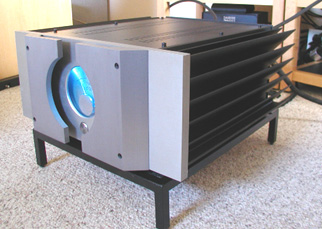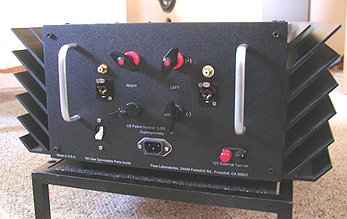You are reading the older HTML site
Positive Feedback ISSUE 6
april/may 2003
pass labs
X250 stereo amplifier
as reviewed by Mark Katz

Photos taken by Dave Clark in his system
MARK KATZ'S SYSTEM LOUDSPEAKERS ELECTRONICS SOURCES CABLES ACCESSORIES
|
The Pass X250 is the 2nd from the bottom of the Pass X series amp line. The smallest is the not so small X150, at 150 watts/channel and at the top are the 1000 watt per monobloc X1000 amps. These amps succeed the excellent Aleph series. The X250 weighs in at 100 pounds, but can be carried by two people with the help of the rear mounted handles. The front has a circular power switch and an attractive blue glowing meter that I believe conveys how much current the amp needs to draw. Wing-like protrusions that can be used as handles surround the meter and the whole amp has a brushed silver look. The back of this rather hefty stereo amp sports both single ended and balanced inputs and clever, large binding posts that are very easy to hand tighten. The binding posts are good for spades, but can’t be used on bananas since there’s nowhere to plug them. Also on the back is the obligatory IEC receptacle for the power cord, and the main power switch. The amp’s operation is intuitive. The manual gives the Nelson Pass design philosophy of low noise, very low distortion, achievable with only 2 stages of amplification and low global feedback using "Supersymmetry" and balanced circuitry. His discussion of distortion minimization makes good reading – in the user’s manual http://www.passlabs.com/pdf/x250man.pdf. Of course, the proof is in the implementation

I unplugged the Kora Cosmos amps and plugged the Pass X250 directly into a dedicated 20 amp outlet using a fairly hefty Tiff power cord. The rest of the system used included a CEC TL1 transport with Marigo Signature digital interconnect into an Audio Magic modified Kora Hermes 192/24 tubed DAC, Kora Eclipse tubed preamp hooked together with Goertz Triode interconnects. The amp drove the JM Labs Mezzo Utopias, a fairly flat 4 ohm, efficient load through shot-gunned (one run on each terminal) Kimber 8TC. The low powered equipment was plugged into an API Powerwedge 116 II, with the preamp into a non transformer filtered outlet. The amp changed the character of my system. Gone was the seductive sound of the Kora Cosmos, in came POWER. The first thing I noticed was a sense of the music becoming more dynamic. On my speakers, it seemed effortless and amazingly energetic. It sounded as if the dynamics of the performances were brought closer to the original. With the possible exception of very high efficiency horn speakers, dynamics of the music reproduced is markedly diminished compared to the original. Many people deride this type of speakers for poor tonal balance and a honky, "cupped hand" sound and with a few exceptions, they’re right. Despite this they can convey lively dynamics that would otherwise be far more compressed on more "audiophile approved" speakers. With this amp, the Mezzos became much more authoritative, closer to this sort of dynamic presentation. I heard this with orchestral music, such as the early Telarc recording of Stravinsky’s Rite of Spring, classical piano, such as a Conifer recording of Kathryn Stott playing Debussy and Ravel (Connifer 75605 51755 2), and the jazz recording on Audioquest of Bruce Katz "Crescent Crawl" AQ - CD 1012. The bass drum sounded deep and strong, the piano key strikes were authoritative, the percussion snapped and double-bass rumbled. The bass range was not tubby or boomy, but tight and tuneful. On the Reference Recording (RR-57CD) of the Rutter Requiem, Pie Jesu, track 7 the organ pedal notes came through better than I’ve ever heard on my speakers. The Mezzos roll off in the low 30 Hz range.
The next thing that came to awareness was the subtlety and detail that the amp revealed. Solid state amps sometimes sound dull and smeared, rolled off in an attempt to sound "tube-like", but good tube amps don’t really sound dull at all. They can, on the opposite end of the spectrum, be etched and overly detailed inducing fatigue. They seem to dissect the music to the point of long term unlistenability or sounding good on just one’s best recorded music. Think of it like a television or video display with the contrast turned up high. Apparent detail is in abundance, but is artificial and unreal. Underlying content may be lost. With the Pass amp, I heard great detail and delicacy at the same time. Harpsichord and vocals on the Dorian recording of Bach’s Coffee cantata (Dorian - #90199) illustrate the point. The harpsichord’s plucked strings and faint resonance were clear. Tenor, baritone, and soprano all had texture, the flute conveyed air moving through it. Joshua Bell’s violin playing Gershwin, Gershwin Fantasy (Sony - #60659) sounded very realistic both in the instrument’s initial bowing or plucking and its resonance.
What was absent was a faint warmth and inner life I associate with the best tube amps. Instead came a feeling that this is what is on the recording, not adulterated, neither sweetened nor spiced. I loved the energy, controlled and powerful bass, and the refinement of this amp with my speakers. Neither harsh and unforgiving or rolled off, the Pass X250 lets one hear into the music in a way that’s hard to believe in such a powerful amplifier. I had thought that relatively low power was a requirement for such subtlety of presentation. Perhaps the simplicity of its two stage design with very low distortion and low global feedback really is a way to get the music to come through. If it had a touch of my Kora Cosmos amps’ sweetness and warmth, the Pass would be a nearly ideal amplifier. Even so, the Pass X250 is simply the finest high powered solid state amp that I’ve had the pleasure to pair with the Mezzo Utopias. Mark Katz

X250 stereo amplifier
Retail $6000
Pass
Laboratories
TEL: 530. 367. 3690
web address: www.passlabs.com
email address: [email protected]
